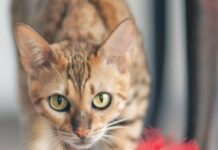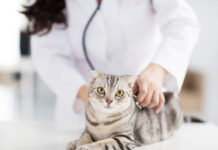Both my cats purr when they are content or happy. But one of them will get up on my neck and start to knead and drool along with her purring. Why do some cats drool when they are happy?
A fair number of cats drool when they experience something pleasurable. When I was a young lad growing up on the farm, several of our cats would absolutely soak my shirt when I held them and scratched their ears. Of course they were purring and kneading the whole time.
Salivation is a necessary component of eating, in part because it lubricates food and facilitates swallowing. It performs a special function when kittens nurse; the saliva helps form an airtight seal between the kittens mouths and the mothers nipples so suckling is more efficient. What about kneading? If youve had the opportunity to witness kittens while they nurse, youve noticed them kneading their paws against their mothers tummy, a gesture believed to stimulate milk flow.
I believe that drooling and kneading triggered by pleasant experiences in some adult cats are linked to those early, pleasurable, kneading/salivating nursing events. I suppose any enjoyable experience could trigger the response, but in my experience, its most often associated with something tactile, like receiving scratches behind the ears or strokes of the head.
Bear in mind that drooling can be caused by any number of disorders of the mouth and gastrointestinal tract, and even certain types of neurological diseases. But if your kitty drools only during her purring/kneading moments, there is nothing to worry about. Just make sure to wear something that kitty slobber wont damage!
———-
How often does a kitty need to be bathed? My kitty is longhaired, and it seems she might need a bath from time to time. Is this something I should do on my own?
Normal cats almost never require bathing, because they spend so much of their time grooming themselves. In fact, frequent bathing can be harmful to the skin. Adult cats spend as much as 30 percent to 50 percent of their waking hours grooming. By using a combination of his tongue (in many ways like a hairbrush in the mouth), teeth and paws (used like washcloths), a cat can reach virtually every part of his body.
Bathing is necessary in a few cases, though. Owners of show cats often bathe their cats to spiff them up right before a show. And there are certain skin conditions that may require relatively frequent bathing. Your veterinarian will provide you with explicit instructions should this become necessary.
If, for some reason, a cat becomes extremely soiled, he may need a bath. Also, an obese cat may simply not be able to reach certain areas of his body – such as the base of the tail or around the anus – and may require a little grooming help or spot bathing from time to time.
Under most circumstances, it is not necessary to bathe a cat. Combing or brushing, however, is very beneficial and ideally should be done at least once a week, depending on the breed of cat, point in the shedding cycle, or tendency of the hair to mat. (Note: Persians, Himalayans and similar breeds may require grooming every day to keep their luxuriant but mat-prone hair free of tangles). Regular grooming helps remove shedding hair before it winds up on the furniture or in a hairball, and it offers the owner an opportunity to examine the cats skin for disease. Plus, many cats seem to enjoy the routine, especially if it is first done when they are youngsters.



